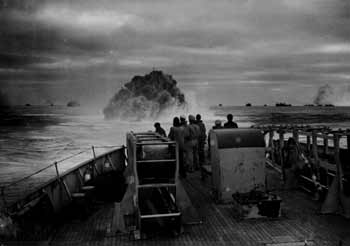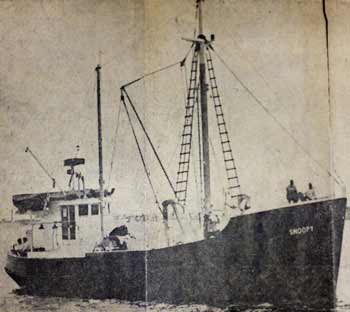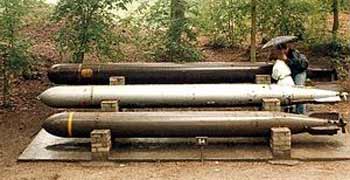Maine Scalloper Sunk By
German Torpedo
by Tom Seymour

U.S. Coast Guard dropping depth charges in the shipping lanes off the mid Atlantic coast of the United States in 1942. German submarines sank hundreds of U.S. merchant ships in an effort to cut off U.S. supplies ranging from food to munitions being sent to England and its allies. The U.S. would later enter the European theater.
In May of 1965, the wooden dragger, Snoopy, left her home port of Portland, Maine, for Cape May, New Jersey, and from there, to a scallop-rich region off of North Carolina.
Scallopers from far and wide, in essence the entire northeastern scallop fleet, had descended upon this fertile scallop-fishing ground. Maine’s scallop beds had become played out and when news broke of the abundant scallops off of the North Carolina coast, it was the best news that Maine scallop fishermen had heard in a long time. And so everyone headed for the rich fishing off of North Carolina.
Out of the 40-some scallopers working that area of Carrituck Sound that night, fate would pick one vessel and mark it for destruction. The path to the Snoopy’s sinking was one littered with “ifs,” as in “if this had happened, or if this hadn’t happened and so on.
One thing is for certain, neither the skipper nor the crew expected to find themselves on the receiving end of a 20-year-old explosive device, a German torpedo left over from World War II.
The Snoopy was a relatively new vessel, built at the Harvey Gamage Shipyard in South Bristol, Maine, beginning in the late 1950s and completed in the early 1960s. She should have had many working years ahead of her, but that day fishing in what commercial fishermen knew as “Torpedo Alley,” changed all that.
Beginning during World War I and recommencing during the Second World War, German subs prowled this area along the mid Atlantic coast known collectively as “Torpedo Junction” and “Torpedo Alley,” in search of targets. In 1942, German U-boats sunk nearly 400 vessels, killing more than 5,000 people, a majority of whom were civilians and merchant mariners. The Germans referred to this time as the “Great American Turkey Shoot.”
But though the war was two decades in the past, the “turkey shoot” continued to claim victims, notably the Snoopy.
The Snoopy had already made three trips to the scallop beds lying some 45 miles east of Carrituck Beach and was engaged in her fourth venture when tragedy struck. At 9:15 p.m. the Snoopy, fishing along with 40 other scallop draggers, was pulling in her supposedly scallop-filled port drag when the crew noticed that something other than scallops was attached. The object was, as it turned out, a torpedo, specifically, a German G7e torpedo which had lain, in situ, since the end of the Second World War.

Portland, Maine scallop dragger Snoopy. While dragging off the North Carolina coast, it brought up a German torpedo which had lain on the bottom for more than 20 years. During an attempt to bring it aboard, it exploded, tearing the wooden boat apart and sinking it. Some torpedoes missed their target or ran out of power, landing on the bottom.
The explosive device had a weight of 3,540 pounds, a length of 23 feet and a diameter of 21 inches. The extreme weight of the torpedo caused the cable to slip on the winch drum as the crew attempted to hoist it.
Captain Edward F. Doody watched the proceedings from the wheelhouse and directed the men to lift the drag and swing it aboard. But that attempt was unsuccessful because the winch hadn’t the strength to lift the torpedo above the rail. After that, the crew affixed a line to the torpedo and the other end to an overhead gallows stay. The reasoning was that by dropping the drag from beneath the torpedo, the torpedo could then be swung aboard. But this effort, like the first one, ended in failure.
So once again, Captain Doody had his crew make another attempt to swing the torpedo aboard. But as the torpedo was being lifted, a swell rolled the Snoopy. This happened as the torpedo was at the end of its swing away from the vessel and the rolling motion of the Snoopy caused the torpedo to swing back, strike the rail and explode.
The force of the exploding torpedo was such that, according to various reports, the Snoopy was, “shattered in a rain of splinters,” “ripped to bits,” “blown to bits” and “blown to smithereens.” A more prosaic account comes from Captain Norman Mallet of New Bedford, Massachusetts, skipper of the trawler “Prowler.” Captain Mallet reported talking on the radio with Captain Doody shortly before the explosion. Captain Doody reportedly said that he “had something in the bag,” and was checking it.
Captain Mallet was close enough to the Snoopy that he could clearly perceive an object swinging in the net near the midsection of the Snoopy, after which there was a “big bang, followed by smoke and then there wasn’t a ship.”
And now for the “what if’s.” The Snoopy had harvested more than enough scallops to simply return home and cash in their bounty for a good return. The decision as to whether or not to make just one more trip could have gone one way or the other. Unfortunately, it was agreed to take full advantage of the abundant scallops and make another run before heading back to Maine.
Another “what if” comes in the form of what might have happened had the vessel not rolled on that fateful swell. Might the crew have been successful at bringing the net and attached torpedo on board without incident? We’ll never know. Of course the captain and crew had absolutely no way of knowing that the torpedo was still viable. Nonetheless, they most certainly would, had they managed to swing it aboard, have exercised the utmost discretion.
The Aftermath

AG7e German torpedo (center) like the one the scallop dragger FV Snoopy brought up. The G7e was the standard German torpedo in WWII. Powered by a lead acid battery, it had a range just over 3 miles. Known to have had electrical problems, the firing mechanism did not.
After the explosion, all the other vessels could find were small bits of floating wreckage. It was immediately clear that the destruction was complete. The search for survivors commenced immediately and continued throughout the night and into the following day. Ships and planes participated in the search, scouring the shark-infested waters for any sign of life.
Eventually, four survivors were found clinging to small bits of debris and brought ashore and immediately sent to the hospital. These survivors, all Mainers, were Peter Leavitt, mate, Harold Martin, cook, Richard Lindahl, deck hand and Leland French, deck hand.
Presumed killed were Captain Doody, Donald Williams, Francis Blastow, Daniel Broy and Raymond Hanson and Bertram Norton, whose body was recovered.
Also, according to a contemporary UPI newspaper release, an unnamed crewman, who had signed on just prior to the Snoopy’s sailing for North Carolina, was listed as missing.
Several years after the smoke had cleared, the surviving crew members, along with personal representatives of the deceased, brought actions against the United States to recover damages for the deaths and personal injuries incurred with the sinking of the Snoopy. Part of their complaint was that the government hadn’t provided sufficient warning of danger from sunken explosives.
However, the court held that the plaintiffs failed to establish a burden of proof against the United States Government as related to the sinking of the Snoopy and the suits were dismissed.
Finally Protection
In February 2016, NOAA announced its proposal to protect World Wars I and II wrecks and wreck sites off the North Carolina coast by including them in the area known as the Monitor National Marine Sanctuary. Thus, ships sunk during the Civil War and up through the Second World War during the Battle of The Atlantic will receive long-deserved protection.
This will protect the wrecks themselves and at the same time, will serve to educate the public regarding the battles that happened in this one-mile-wide stretch of water. Diving and fishing around the wrecks will be permitted.
No one who has not experienced life-and-death incidents at sea can fully comprehend the horror and full-blown terror that filled those survivors who floated about on shreds of wreckage during that long night. Four of these were saved, the rest perished. It is only fitting and right that these and other victims of Torpedo Alley be memorialized and remembered.
